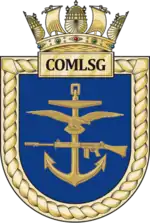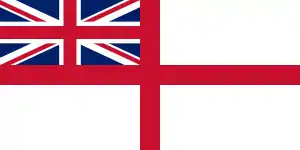Commander Littoral Strike Group
The Commander Littoral Strike Group, (COMLSG), until 2019 termed Commander Amphibious Task Group, (COMATG), is a senior British Royal Navy appointment. It was first established in May 1965 as Commodore Amphibious Warfare, a title originally held by Commodore, Amphibious Forces, Far East Fleet until 1971, whereupon it transferred back to the UK. The office holder today commands the Littoral Strike Group, which makes up the majority of the Joint Expeditionary Force (Maritime), including at least one of the Queen Elizabeth-class aircraft carriers.
| Commander Littoral Strike Group, (COMLSG) | |
|---|---|
 Official badge of COMLSG | |
Incumbent Commodore Rob Pedre since May 2020 | |
| Navy Command, Ministry of Defence | |
| Reports to | Commander United Kingdom Strike Force |
| Appointer | Naval Secretary |
| Term length | Not fixed (typically 2 years) |
| Inaugural holder | Commodore Hardress Lloyd |
| Formation | 1965-current |
History
First created in May 1965 as Commodore Amphibious Warfare (COMAW), upon establishment the role was tied to the separate post of Commodore, Amphibious Forces, Far East Fleet (COMAFFEF), which was based at Singapore Naval Base after the Royal Navy’s Amphibious Warfare Squadron was transferred from Middle East Command to the Far East Fleet. In March 1971, following the withdrawal from Singapore, and the return of 3 Commando Brigade to the UK, COMMAFFEF was abolished and COMAW and his staff moved to Fort Southwick, just outside Portsmouth.[1]
In 1981, Commodore Michael Clapp moved COMAW to Stonehouse Barracks in order to be based alongside HQ 3 Commando Brigade again. Following the pivotal role of the Royal Navy’s amphibious forces during the Falklands War, when Cdre Clapp directed the Amphibious Group of the British task force, alongside Brigadier Julian Thompson, this co-location of the two Headquarters has endured ever since.[2]
The position was renamed from COMAW to Commander Amphibious Task Group (COMATG) on 1 December 1997,[3] following the establishment of the Amphibious Warfare Squadron in March 1997.[4] From 1965 to 1971, the post reported to Commander-in-Chief, Far East Fleet, and after return to the UK, from 1971 to 1979 the post holder reported to Flag Officer, Carriers and Amphibious Ships. From 1979 to 1992 he reported to the Flag Officer, Third Flotilla,[5] and from 1992 has reported to the two-star deployable battlestaff commander, currently titled Commander UK Strike Force.[6]
Until 2011, COMATG was one of the three deployable maritime headquarters who reported to the battlestaff, along with the Commander of the United Kingdom Carrier Strike Group (COMCSG) and the Commander of the UK Task Group (COMUKTG). However, following the Strategic Defence and Security Review 2010, COMCSG and COMUKTG were abolished as separate commands and COMATG became the sole deployable HQ, under the new title of COMUKTG, responsible for command of the Response Force Task Group (RFTG). At this point, the former Commander UK Task Group became Deputy Commander United Kingdom Maritime Forces.[7]
In March 2015, this reorganisation was partially reversed when the post of COMUKTG reverted to its previous title of COMATG,[8] and the RFTG became the Joint Expeditionary Force (Maritime).[9]
COMATG was re-titled as COMLSG on 1 October 2019, to reflect the expanded role of the post to incorporate Queen Elizabeth-class aircraft carriers at the heart of a new Littoral Strike Group.[10][11]
Roles and Responsibilities
COMLSG is one of the Royal Navy's deployable one-star Maritime Component Commander held at Very High Readiness (72 hours or less) in order to respond to unexpected global events. In most circumstances, COMLSG and his staff would deploy in the Fleet Flagship (such as HMS Albion, or one of the new QE Class Aircraft Carriers) in order to command the maritime element of the UK's Joint Expeditionary Force (Maritime) Task Group. While structured and trained to conduct high intensity war-fighting (with an emphasis on amphibious operations, working alongside Commander 3 Commando Brigade Royal Marines), COMLSG staff are capable of commanding a diverse range of activities such as evacuation operations, or disaster relief. COMLSG, who is based in Royal Marines Barracks Stonehouse, reports to Commander United Kingdom Strike Force.[12]
Deployments and Operations
- Op VERITAS 01
- Op TELIC 03
- Op VELA 06
- Op HIGHBROW 06
- CTF 152 08
- TAURUS 09
- COUGAR 11
- Op ELLAMY 11
- COUGAR 12
- Op PATWIN 13
- COUGAR 13
- COUGAR 14
- COUGAR 15
- Op WEALD 15
- JEF(M) 16[13]
- CTF50 17[14]
- Amphibious Task Group 18[15]
- SAIF SAREEA 3 18[16]
- BALTIC PROTECTOR 19[17]
- Op SENTINEL 20 (International Maritime Security Construct)[18]
- Littoral Response Group (Experimentation) Deployment 20 [19]
In command
Included:[20]
Commodore, Amphibious Warfare
- Commodore Hardress L. Lloyd: May 1965-May 1966
- Commodore David Dunbar-Naismith DSC: May 1966-July 1967
- Commodore Gerard Mansfield: July 1967-November 1968
- Commodore Thomas W. Stocker: November 1968-September 1970
- Commodore Derek W. Napper DSC: September 1970-August 1971
- Commodore Roy W. Halliday DSC: August 1971-September 1973
- Commodore David T. Smith: September 1973-October 1975
- Commodore Richard D. Franklin: October 1975-February 1977
- Commodore Derek R. Reffell: June 1978-October 1979
- Commodore Christopher J. Isacke: October 1979-May 1981
- Commodore Michael Clapp CB: May 1981-February 1983 [21]
- Commodore Peter G. V. Dingemans DSO: February 1983-January 1985 [22]
- Commodore John Garnier CBE LVO: January-July 1985
- Commodore E.S. Jeremy Larken DSO: July 1985-December 1987
- Commodore Brian W. Turner: December 1987-April 1990
- Commodore Peter J. Grindal: April 1990-April 1992
- Commodore Richard A.Y. Bridges: April 1992- July 1994
- Commodore Paul B.C. Canter CBE: July 1994-October 1996
- Commodore Paul D. Stone: October 1996-1 December 1997
Note: COMAW was renamed COMATG in 1997[23]
Commander, Amphibious Task Group
Commodores in post included:[24]
- Commodore Paul D. Stone: 1 December 1997-1998
- Commodore Niall S.R. Kilgour: 1998-July 2001
- Commodore A. James G. Miller: July 2001-September 2003
- Commodore Christopher J. Parry: September 2003-January 2005
- Commodore George M. Zambellas: January 2005-August 2006
- Commodore Philip A. Jones: August 2006-2008
- Commodore Peter D. Hudson: 2008-May 2009
- Commodore Paul M. Bennett: May 2009-January 2011
Note: Following SDSR10, COMATG was renamed COMUKTG, and the Amphibious Task Group was renamed the Response Force Task Group.[25]
Commander, U.K. Task Group
Commodores in post included:[26]
- Commodore John M. L. Kingwell: January-November 2011
- Commodore Patrick A. McAlpine: November 2011-February 2014
- Commodore Jeremy P. Kyd: February 2014-February 2015
- Commodore Martin J. Connell: February 2015-March 2015[27]
Note: COMUKTG post reverted to the name Commander Amphibious Task Group in March 2015, and Cdre Connell continued in that role till May 2016[28]
Commander, Amphibious Task Group
Commodores in post included:[29]
- Commodore Martin J. Connell: March 2015-May 2016
- Commodore Andrew P. Burns: May 2016-May 2018
- Commodore James M.B. Parkin: May 2018-October 2019[30]
Note: COMATG was renamed Commander Littoral Strike Group in October 2019, and Cdre Parkin continued in post under the new title.[31]
See also
References
Footnotes
- Clapp, Michael; Southby-Tailyour, Ewen (1996). Amphibious Assault Falklands: The Battle of San Carlos Water. Naval Institute Press. ISBN 978-1557500281.
- Ewen Southby-Tailyour and Michael Clapp Amphibious Assault Falklands: The Battle for San Carlos [Leo Cooper/Orion, 1996]
- Navy News: Dec 97 Edition Page 10
- Navy News: Mar 97 Edition Page 42
- Harding, Richard (2005). The Royal Navy, 1930-2000: Innovation and Defence. London, England: Psychology Press. p. 237. ISBN 9780714657103.
- "HMS Queen Elizabeth to get a new captain as former CO is promoted". Portsmouth News. 9 January 2020. Retrieved 22 February 2020.
- "Simon Ancona, Deputy Commander, UK Maritime Forces" (PDF). SMI. Retrieved 22 February 2020.
- Royal Navy: New CO for Amphibious Task Group
- "HMS Ocean deploys on joint expeditionary force". Royal Navy. Retrieved 23 September 2016.
- Rosamond, Jon (11 September 2019). "DSEI: Royal Marines Embrace Littoral Strike and Prepare to Forward Deploy". USNI News. London. Retrieved 1 October 2019.
- "Navy News February 2020". Navy News. 2 March 2020. Retrieved 5 March 2020.
- "Navy Command Operating Model V3" (PDF). gov.uk. Royal Navy. p. 134. Retrieved 27 October 2018.
- "UK's Amphibious Task Group deploys for operations". Royal Navy. Retrieved 27 September 2016.
- "Royal Navy leads US Task Force 50 for the first time". Royal Navy. Retrieved 27 January 2017.
- "Joint Staffs Arrive for ATG18". Twitter. Retrieved 27 September 2018.
- "Royal Navy task force poised for major Middle East test". Royal Navy. Retrieved 27 October 2018.
- "UK-Led Joint Expeditionary Force Exercise in The Baltic Sea, One of the Exercise Phases Will be Conducted on Lithuania's Coast in June". Defense Aerospace. France. 25 May 2019. Retrieved 10 June 2019.
- "British Officer takes command of Gulf maritime security mission". gov.uk. Retrieved 27 February 2020.
- "HMS ALBION LEADS UK TASK GROUP FOR THREE-MONTH MED DEPLOYMENT". Royal Navy. 14 September 2020. Retrieved 15 September 2020.
- Mackie, Colin (August 2018). "Royal Navy Senior Appointments from 1865". gulabin.com. C. Mackie. p. 218. Retrieved 8 August 2018.
- Keleny, Anne (29 January 2016). "Rear-Admiral Peter Dingemans: Falklands War naval officer". The Independent. London, England: Newspaper Publishing PLC. Retrieved 8 August 2018.
- "Rear-Admiral Peter Dingemans - obituary". The Daily Telegraph. London, England: The Telegraph Media Group. 31 December 2015. Retrieved 8 August 2018.
- Mackie pp.218-219
- Mackie pp.218-219
- Mackie pp.218-219
- Mackie pp.218-219
- "New commanding officer announced for Royal Navy task force". Royal Navy. Retrieved 27 October 2018.
- Mackie pp.218-219
- Mackie pp.218-219
- "New commander for Royal Navy's Amphibious Task Group". Royal Navy. Retrieved 27 October 2018.
- Mackie pp.218-219
- Rosamond, Jon (11 September 2019). "DSEI: Royal Marines Embrace Littoral Strike and Prepare to Forward Deploy". USNI News. London. Retrieved 1 October 2019.
- "UK'S AMPHIBIOUS FORCES CHANGE HANDS". Royal Navy. 22 May 2020. Retrieved 22 May 2020.
Sources
- Harding, Richard (2005). The Royal Navy, 1930-2000: Innovation and Defence. London, England: Psychology Press. ISBN 9780714657103.
- HM Government UK. (2015). MOD UK. Royal Navy.
- Keleny, Anne (2016). "Rear-Admiral Peter Dingemans: Falklands War naval officer". The Independent. London, England: Newspaper Publishing PLC.
- Mackie, Colin. (2018) "Royal Navy Senior Appointments from 1865" (PDF). gulabin.com. Colin Mackie. Scotland, UK.
- The Daily Telegraph. (2015). London, England: The Telegraph Media Group.
